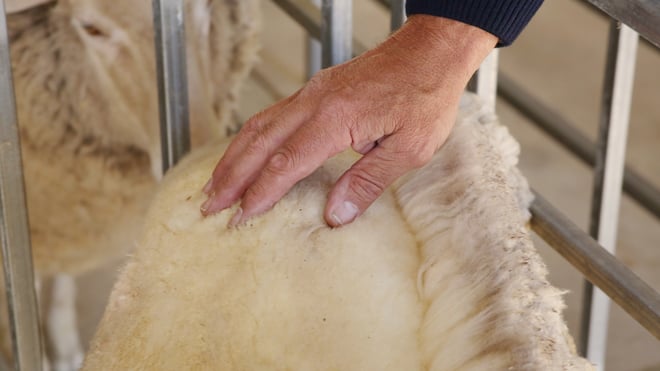AWI’s biological wool harvesting project moves to second phase

The Australian Wool Innovation (AWI) project to develop a new opportunity for the biological harvesting of wool is progressing well, with four organisations now contracted to develop ways to harvest the wool above the weakened zone via a device that applies a force to separate the wool from the body of the sheep.
This second phase of the project follows on from the first phase, in which researchers from the University of Adelaide have used a biological agent to create a weakened zone at the base of the wool fibre that enables the fleece to remain on the sheep without a net until the wool can be mechanically removed.
AWI Chief Executive John Roberts says this is important research.
“AWI is strongly committed to this project. It shows the value of ongoing investment in on-farm research to benefit woolgrowers. There is much to do and we continue to work closely with project partners to make this a practical alternative to traditional shearing. This is truly exciting research.
AWI Program Manager, Animal Wellbeing and Industry Resilience, Carolina Diaz says there are two streams of work underway.
“The University of Adelaide researchers are confident that the biological agent works and they are continuing with more testing. However, without a practical, cost-effective, and efficient way to harvest the wool, biological wool harvesting is unlikely to be a strong alternative to traditional shearing, even if the biological part of the project is a success.
“AWI therefore last year issued a worldwide Request for Proposals for the development of a variety of wool removal systems; 14 proposals for funding were submitted to AWI. AWI is progressing with four of the proposals, which each take a different approach to removing the wool.”

AWI Program Manager Animal Wellbeing and Industry Resilience, Carolina Diaz, discussing biological wool harvesting with woolgrowers at a demonstration day last year at Conargo, NSW.
University of Technology Sydney (UTS)
Building on previous AWI-funded research undertaken by UTS on wool handling automation, this project uses belt friction to remove and separate the wool from the sheep. The belts interact with a suction mechanism to transport wool to a desired location in the shed. The project will examine animal handling and robotic control of the wool removal mechanism. It will also build on previous work done by UTS to develop a semi-autonomous wool inspection and classification, and wool handling and baling system.
University of Wollongong
This project will develop four systems for biological wool harvesting that have increasing levels of complexity, but also increasing potential for cost savings: an initial wool removal mechanism that primarily utilises suction; a manually operated handpiece that utilises the vacuum mechanism; a semi-autonomous system that automatically removes the majority of the fleece but still requires a human shearer to remove wool from the belly/legs/head; and a fully autonomous system (from sheep to classer).
Agricultural Technology Solutions
This Australian-based company is undertaking R&D into a fully integrated biological wool harvesting system. The design will incorporate animal positioning/handling; fibre severance and wool removal utilising tangential pneumatic force via multiple air blades, or incorporated with hydro or mechanical assistance; fibre quality assessment; and collection and transfer of the wool to the bale.
Brooke and Mackenzie Pty Ltd
Building on previous AWI-funded research, Brooke and Mackenzie is re-examining a handpiece, first designed for defleecing 15 years ago, to assess its suitability and development for biological wool harvesting. While a standalone handpiece without a wool transport or handling system might not be the optimal choice for a wool harvesting system, having a functional handpiece could prove useful in the short term.
“The development of a mechanical wool harvesting system is a significant challenge, especially the development of a fully automated system to address the full range of different harvesting components,” Carolina said.
“The four projects include clear Go/No-Go stages linked to whether the researchers achieve significant milestones. This includes an early Go/No-Go point involving prototypes being tested later this year on treated sheep provided by the University of Adelaide. The management model being applied by AWI will reduce investment risks and enable collaboration between participants.”
Biological wool harvesting is an example of the multi-pronged approach that AWI is taking to make wool harvesting easier and more cost-effective for woolgrowers and the Australian wool industry.

A sheep treated for biological wool harvesting that has had some of its wool harvested for demonstration purposes, on show at a demonstration day last year at Katanning, WA.















